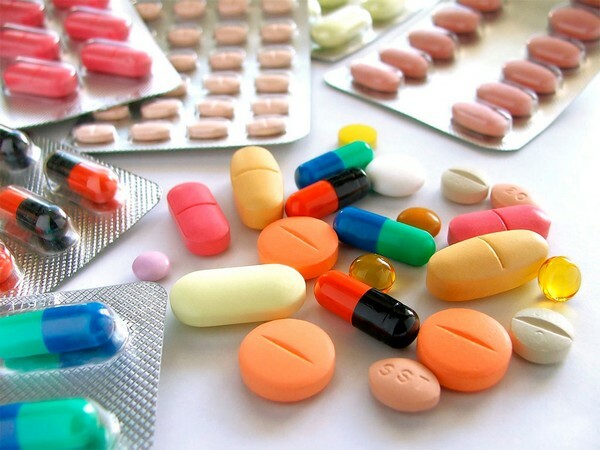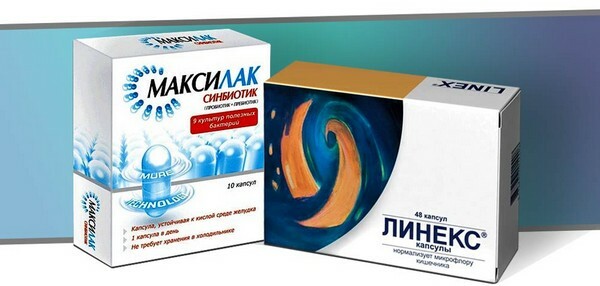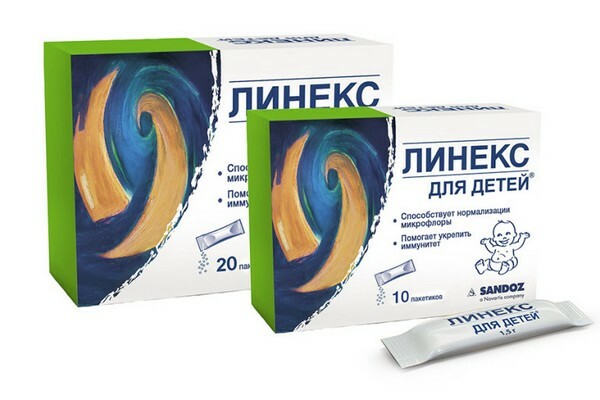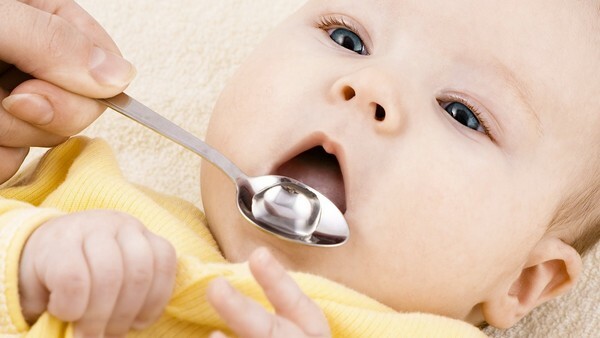Contents:
- Why probiotics are used during antibiotic therapy
- Consequences of antibiotic therapy
- How to choose the best probiotic
- How to take probiotics with antibacterial drugs
Antibiotics from various groups are used to treat respiratory and intestinal infections provoked by pathogenic bacteria. Their use helps to quickly eliminate both the cause of the pathological condition and its clinical manifestations. But antibiotic therapy has one significant drawback - the ability to suppress useful intestinal microflora. The resulting deficiency of lacto- and bifidobacteria causes diarrhea and abdominal pain. To prevent dysbiosis, doctors prescribe probiotics to patients when taking antibiotics. The use of drugs with beneficial bacteria is an excellent prevention of pseudomembranous colitis and idiopathic diarrhea.

Why probiotics are needed during antibiotic therapy
Many doctors prefer to use local antibiotics in the form of throat sprays or resorption tablets in the therapy of respiratory infections. Such drugs are very effective at the initial stage of the disease:
- rapidly destroy staphylococci and pneumococci;
- prevents the spread of infectious agents;
- helps to stop inflammation.
Of great importance is the inability of these antibiotics to enter the systemic circulation in significant concentrations. This means that small and adult patients can not be afraid for the state of their intestinal microflora. But with complicated pathologies, one can not do without the use of systemic antibiotics:
- semisynthetic protected and unprotected penicillins;
- macrolides;
- antibacterial agents of cephalosporin series;
- fluoroquinolones;
- aminoglycosides.
The bactericidal action of systemic antibiotics is not limited to palatine tonsils or inflammatory focuses on the mucous membrane of the throat. They penetrate into the bloodstream, creating the maximum therapeutic concentration in the tissues. Including the large intestine. The active ingredients of antibacterial drugs begin to destroy the cell walls of useful lacto- and bifidobacteria, inhibit growth and reproduction, and cause death.
It is interesting: In a person with strong immunity after systemic antibiotic therapy, there are no negative consequences for peristalsis and digestion. Even with the death of a large number of beneficial microorganisms, the population of bifido- and lactobacilli is quickly restored.
The reception of probiotics after antibiotics promotes the colonization of the intestine with new strains of beneficial microbes. The course treatment helps to normalize the digestive tract and even increase the immunity weakened by the disease. And the use of probiotics during antibiotic therapy will allow to avoid negative symptoms of dysbiosis at all.

Consequences of antibiotic therapy
To accept or not to take probiotics together with antibiotics, only the attending physician should decide. Among doctors there is no general opinion on the effectiveness of this method of preventing dysbacteriosis. Many of them believe that there is no need to burden the weakened respiratory or intestinal infection of the body with additional drugs. In addition, pseudomembranous colitis and idiopathic diarrhea do not develop in all cases. Other doctors warn of the possibility of developing dysbiosis, which in some cases becomes the cause of the spread of pathogenic bacteria throughout the body. So, patients need to fully trust the doctor in this matter.
Idiopathic Diarrhea
The course of antibiotics from any group provokes the death of beneficial microflora in the large intestine. As a rule, antibacterial agents do not show bactericidal activity against a certain class of microorganisms, and they immediately destroy lactobacilli, bifidobacteria, and enterococci. At the adult and the child digestion is broken, but diarrhea becomes the most pronounced symptom. Doctors prefer to immediately assign a probiotic, without waiting for the body to restore the biocenosis on its own. What drugs are most effective:
- Linex Forte, Linex for children;
- Bifiform;
- Hilak Forte.
After several days of using probiotics, the work of the gastrointestinal tract is normalized. But to consolidate the positive result of treatment, the therapeutic course should be fully completed.
Advice: With not very pronounced diarrhea, the number of bacteria in the intestines can be increased by using natural sour-milk products without dyes and preservatives - yogurt, kefir, ryazhenka, varenets.

Pseudomembranous colitis
This consequence of antibiotic therapy is more dangerous and, oddly enough, to eliminate pseudomembranous colitis, you need to take all the same antibacterial agents. In people with weak immunity, after the death of beneficial bacteria, clostridia actively grow and multiply. These gram-negative microorganisms always live in the intestines of adults and children, without provoking any negative symptoms. And in the absence of bifido- and lactobacilli, previously controlling their numbers, clostridia rapidly increase their population. Developed intestinal infection, the main clinical manifestations of which include:
- increase in body temperature above subfebrile values (38.5 ° C);
- pain in the epigastric region;
- diarrheal disorders - nausea, sour belch, heartburn, vomiting, diarrhea.
Clostridia begins to move up the gastrointestinal tract, forming new inflammatory foci. To prevent the spread of infection, gastroenterologists prescribe antibiotics simultaneously with probiotics. In this case, the doctor selects drugs with a high content of saccharomycetes or lactobacilli:
- Acipol;
- Lactobacterin;
- Enterol.
Sulfonylamides( Co-trimoxazole, Biseptol), intestinal antiseptics( Enterofuril, Furazolidone) and antimicrobial agents( Metronidazole, Trichopolum) may also be included in the therapeutic regimen. To strengthen immunity in the treatment of pseudomembranous enterocolitis, it is not enough to take only probiotics. Adults and children are also recommended to receive a course of multivitamins with microelements( Selmevit, Centrum, Complivit).

powders after taking antibiotics. How to choose the best probiotic
An experienced pediatrician or gastroenterologist, when complaining about an adult or a child for painful diarrhea, immediately appoints a probiotic that contains a variety of useful microorganisms. But he will immediately send the patient to the laboratory to take a biological sample( usually feces) for analysis. After 1-2 days, according to the results of the research, it becomes clear that a shortage of which bacteria appeared in the intestine. Then the drug is replaced by the most suitable probiotic, which includes a high concentration of necessary microorganisms.
Principle of selection
During the course of antibiotic therapy, it is not practical to use Probifor, Bifidumbacterine Forte, Florin Forte. These medicines contain not only bifidobacteria, but also minute particles of adsorbent - activated carbon. Antibiotics, regardless of the method of taking probiotics, will quickly destroy useful microorganisms. And activated charcoal in turn adsorbs on its surface antibacterial agents. Thus, the course of taking both antibiotics and probiotics will not have the expected therapeutic effect.
During the treatment of respiratory or intestinal infections by macrolides, aminoglycosides or cephalosporins, it is better to take probiotic drugs that contain not bacteria, but sugar fungi:
- Bactisporin;
- Enterol.
Active ingredients of antibiotics have no effect on them, so useful fungi freely penetrate into the large intestine and begin to actively reproduce there. Simultaneously, they suppress the growth of clostridia and their release into other parts of the gastrointestinal tract.
Recommendation: When choosing a drug that helps prevent the development of dysbiosis, preference should be given to probiotics with a high content of lactobacilli. These microorganisms are most resistant to bactericidal action of antibacterial agents.

. Basic selection criteria for
. Which probiotic is better for antibiotics, the attending physician decides. He assesses the overall health of a small or adult patient, the stage of the course of the pathological process and the duration of the therapeutic course. One-time and daily doses of antibacterial agents are also important. Antibiotics, taken in small amounts, rarely becomes the cause of dysbiosis. But a high dose of cephalosporins, macrolides or semisynthetic penicillins can provoke not only idiopathic diarrhea, but also pseudomembranous colitis.
It is interesting: Dry probiotics - Evitalia and Narine - have proven themselves in the prevention of dysbacteriosis. They are used for fermenting milk in order to obtain lacto- and bifidobacteria enriched with fermented milk mixtures.
Cost does not in all cases become a criterion for the quality of probiotics. When choosing drugs to eliminate the negative consequences of antibiotic therapy, doctors consider the following parameters:
- the speed of the maximum therapeutic effect;
- presence of a small number of side effects;
- the minimum frequency of reception during the day;
- method of consumption, not requiring the presence of food in the gastrointestinal tract;
- usability in the therapy of dysbiosis in children, especially newborns and babies.
For the treatment of babies, liquid dosage forms of probiotics are most often used, which can be conveniently dosed with a measuring spoon or cap. And adults are better to take drugs in capsules or dragees. They can be taken to the service, on long trips and travel.
Advice: Do not choose probiotics according to the principle - the more bacteria in the composition, the more useful the drug. The main criterion for preferring one drug to another should be only the results of laboratory tests and indications for use.
How to take probiotics with antibacterial drugs
Before taking probiotics while taking antibiotics, you need to familiarize yourself with the basic principles of proper therapy. Only in this case the treatment will be appropriate and safe, and the money will not be wasted. If in the gastrointestinal tract both probiotics and antibiotics are at the same time, the beneficial bacteria will be instantly destroyed by antibacterial agents. The time interval between the use of drugs should be 2-3 hours, and if possible and more. What else you need to know about the combination:
- probiotics can not be washed down with hot drinks, since the beneficial bacteria are very sensitive to high temperatures;
- should be taken in a strictly prescribed amount of the doctor, without interrupting the therapeutic course;
- if probiotics were not taken during antibiotic therapy, then they should be consumed as early as possible.
Both antibiotics and probiotics are absolutely not combined with alcoholic beverages. Under the negative effect of ethanol, a significant portion of useful lacto- and bifidobacteria, as well as saccharomycetes, perishes. A combination of antibacterial agents with ethyl alcohol will cause the development of severe side effects.
